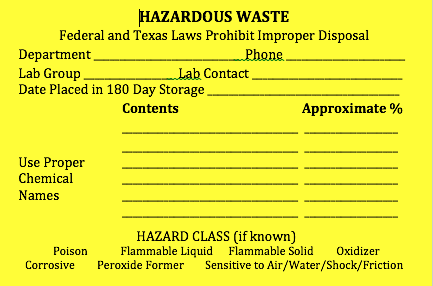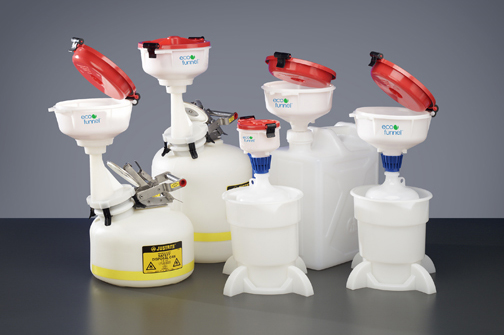Hazardous Waste
Southern Methodist University's Environmental Health and Safety (EHS) group coordinates and manages the University's hazardous waste programs. All hazardous materials must be disposed of in accordance with state, federal, and local law. For information about classification, disposal, and collection, please refer to the below guide.
Quick Links
Hazardous waste collection form
Hazardous Waste Determination
Prior to disposal, the generator must determine if the waste they are generating meets the definition of a hazardous waste. If the substance meets any of the below classifications, it must be collected for disposal as a hazardous waste.
Ignitability
- Liquids with a flash point of less that 60C (140F).
- A solid that can cause fire by friction, absorption of moisture or spontaneous chemical changes.
- Flammable compressed gas.
- Oxidizers that stimulate combustion.
Corrosivity
- pH of less than or equal to 2 or greater than or equal to 12.5.
- Liquid substances that corrode steel at a rate of greater than 6.35mm (0.25in) per year at 55C (130F).
Reactivity
- Unstable and readily undergoes violent change without detonating.
- Reacts violently with water.
- Forms potential explosive mixtures with water.
- When mixed with water, it generates toxic gases, vapors, or fumes in quantities dangerous to human health or environment.
- A cyanide or sulfide-bearing waste that, when exposed to pH conditions between 2 and 12.5, can generate toxic gases the present a danger to human health or the environment.
- Capable of detonation or explosive reaction if it is subjected to strong initiating source or if heated under confinement.
- Is readily capable of detonation or explosive decomposition at standard temperature and pressure.
- Classified as an explosive according to the Department of Transportation.
Toxicity
- Resides on the Toxicity Characteristic list published by the EPA per 40 CFR 261.24.
- Is dangerous to human health or environment based on generator knowledge.
Listed Waste
- F List (40 CFR 261.31) is waste from non-specific sources such as spent solvents.
- F001 - Tetrachloroethylene, trichloroethylene, methylene chloride, 1,1,1-trichloroethane, carbon tetrachloride, and chlorinated fluorocarbons; all spent solvent mixtures/blends used in degreasing containing, before use, a total of ten percent or more (by volume) of one or more of the above halogenated solvents or those solvents listed in F002, F004, and F005; and still bottoms from the recovery of these spent solvents and spent solvent mixtures
- F002 - Tetrachloroethylene, methylene chloride, trichloroethylene, 1,1,1-trichloroethane, chlorobenzene, 1,1,2-trichloro-1,2,2-trifluoroethane, ortho-dichlorobenzene, trichlorofluoromethane, and 1,1,2-trichloroethane; all spent solvent mixtures/blends containing, before use, a total of ten percent or more (by volume) of one or more of the above halogenated solvents or those listed in F001, F004, or F005; and still bottoms from the recovery of these spent solvents and spent solvent mixtures
- F003 - Xylene, acetone, ethyl acetate, ethyl benzene, ethyl ether, methyl isobutyl ketone, n-butyl alcohol, cyclohexanone, and methanol; all spent solvent mixtures/blends containing, before use, only the above spent non-halogenated solvents; and all spent solvent mixtures/blends containing, before use, one or more of the above non-halogenated solvents, and, a total of ten percent or more (by volume) of one or more of those solvents listed in F001, F002, F004, and F005; and still bottoms from the recovery of these spent solvents and spent solvent mixtures
- F004 - Cresols and cresylic acid, and nitrobenzene; all spent solvent mixtures/blends containing, before use, a total of ten percent or more (by volume) of one or more of the above non-halogenated solvents or those solvents listed in F001, F002, and F005; and still bottoms from the recovery of these spent solvents and spent solvent mixtures
- F005 - Toluene, methyl ethyl ketone, carbon disulfide, isobutanol, pyridine, benzene, 2-ethoxyethanol, and 2-nitropropane; all spent solvent mixtures/blends containing, before use, a total of ten percent or more (by volume) of one or more of the above non-halogenated solvents or those solvents listed in F001, F002, or F004; and still bottoms from the recovery of these spent solvents and spent solvent mixtures
- P List (40 CFR 261.33) materials are unused acutely hazardous materials (laboratory chemicals having an LD50 of less than 50mg/kg [oral;rat]). It is usually applicable to surplus chemicals disposed of by research laboratories.
- U List (40 CFR 261.33) are unused hazardous materials such as benzene and acetone.
Class I Waste
- Wastes that are not regulated by EPA but are regulated by TCEQ.
- Examples include soils contaminated with hydrocarbons, sandblasting sand with leachable lead, used oil, and solids that can form a corrosive solution.
Accumulation Requirements
Containers
- Containers must be in good condition, not leaking, and must be compatible with the waste being stored. EHS encourages bulking whenever possible, allowing for head space in case of contents expansion. 5 gallon carboys and 30 gallon closed-top (for liquids) drums are provided by EHS to the laboratories at no cost. All waste containers must be:
- Clearly labeled with “Hazardous Waste” with the contents indicated. EHS recommends using the below label, available in your mail room or from EHS.

- Stored at or near the point of generation and under control of the generator.
- Compatible with contents.
- CLOSED AT ALL TIMES except when waste is physically being added. Funnels must not be left in containers unless they are closed and latched to protect from spills and leaks. An example of these specialized funnels is below:

Accumulation and Segregation
The generator may accumulate up to 55 gallons of hazardous waste or 1 quart of “P-listed” acutely hazardous waste at or near the point of generation. Ensure that waste is segregated whenever possible. ALWAYS ensure that incompatible waste streams are stored separately. In general, the following categories should be separated whenever possible for ease of disposal:
- Miscellaneous solids and grossly contaminated supplies should be collected separately from liquids
- Halogenated solvents
- Non-halogenatd solvents
- Used oil (this can be recycled if not contaminated)
- Acids
- Bases
- Aqueous metal containing waste
- Mercury waste
- Special wastes such as peroxides, cyanides, oxidizers, etc.
Disposal Procedures
Vendors collect hazardous waste approximately every other month to ensure that SMU remains a small quantity generator. It is the laboratory's responsibility to ensure that waste is dropped off and labeled properly. Generators must drop off their waste in DLSB 124 (located inside DLSB 126) prior to dropped off date. In most cases, dropped off dates are scheduled twice a month on Mondays from 1 pm to 3 pm. If necessary, you may request additional dropped off date by contacting Gloria Ruiz. Per federal regulations, you cannot accumulate more than 55 gallons of hazardous waste or 1 quart of acutely toxic waste in a laboratory space.
Lyle School of Engineering (including East Campus locations), Meadows School of the Arts, Meadows Museum, and the Physical Plants will all be collected by vendors escorted by EHS representatives.
Dedman Life Sciences, Fondren, and Heroy laboratories will be dropped off by laboratory personnel during the scheduled “dropped off date” and before the “vendor pickup” date in order to expedite the process.
Please follow the below instructions for waste drop off:
- Hazardous waste must be transported on a plastic cart that has side walls. If you do not have one available, there is one available in the waste drop off area to borrow (labeled SMU EHS).
- Upon drop off, the laboratory may collect the same number of empty containers as full containers dropped off.
- As always, all hazardous waste containers must be tightly closed and appropriately labeled with all of the required information
- Only waste with known chemical composition that is appropriately labeled are eligible for waste collection.
- Please only transport a maximum of 20 gallons of hazardous weight at a time (each EHS supplied waste jug is 5 gallons).
- Please use two people for transporting waste to assist with moving throughout the buildings.
- A waste room attendant from EHS MUST be present for drop off.
All waste must be labeled in accordance to the process outlined above prior to dropped off. Waste that does not meet the accumulation requirements will not be collected.
Empty Containers
Containers previously containing liquids must be completely emptied of pourable contents. Once they are empty, the label should be defaced and labeled as “EMPTY”. The cap should be disposed of separately in the normal trash. The container can go out as regular trash at this point.
NOTE: Any containers that contained acutely hazardous substances must be picked up as part of the hazardous waste program and should not be disposed of in the regular trash.
EHS encourages the reuse of chemical containers as waste collection vessels provided the original contents are compatible with the waste collected, the container is in good condition, and proper labels are affixed.
Universal Waste
Universal wastes are hazardous wastes that are more common at facilities and are managed differently than traditional laboratory research wastes. They usually pose a lower risk to people and the environment and have simplified management regulations. Examples of Universal Waste include:
- Batteries
- Certain pesticides
- Mercury-containing equipment and thermometers
- Paint and paint-related waste
- Electronics-related equipment
- Lamps and light bulbs
Universal Waste disposal is co-managed by EHS and Facilities Services. All questions should be directed to EHS regarding disposal.
For all questions and inquiries, please contact Gloria Ruiz-Research Safety Manager.